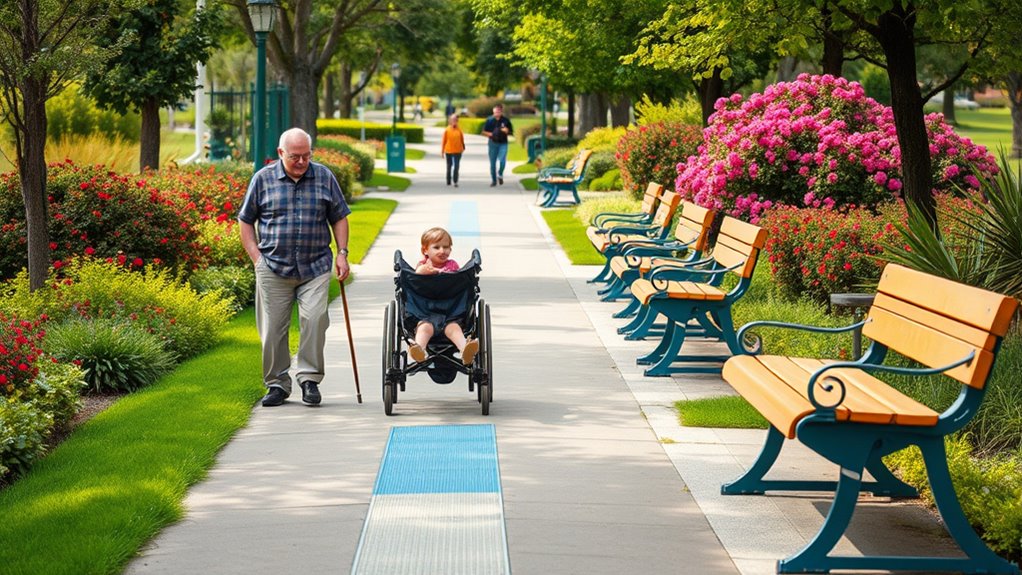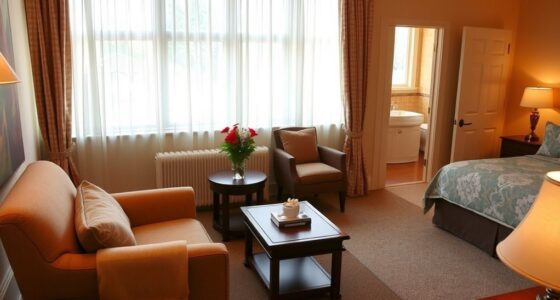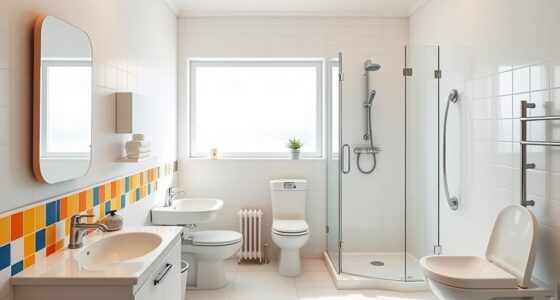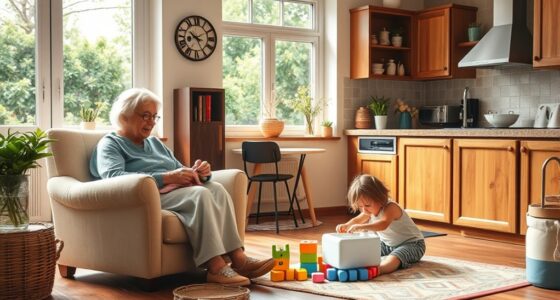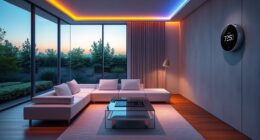Universal design benefits everyone by creating environments that are safe, comfortable, and easy to use, regardless of age or ability. It includes features like smooth pathways, ramps instead of stairs, and smart home technology that simplifies daily routines. These thoughtful adjustments promote independence, safety, and social engagement for people of all ages. Keep exploring how these inclusive features can transform your spaces and make life easier for everyone involved.
Key Takeaways
- Inclusive environments that are safe, comfortable, and usable for people of all ages and mobility levels.
- Small design adjustments, like ramps and automated systems, significantly enhance accessibility and safety.
- Smart home technology simplifies daily routines and supports independence for users with diverse needs.
- Outdoor features such as level pathways and handrails promote outdoor activity and social interaction for everyone.
- Proactive planning with universal design creates adaptable spaces that benefit all users throughout their lives.
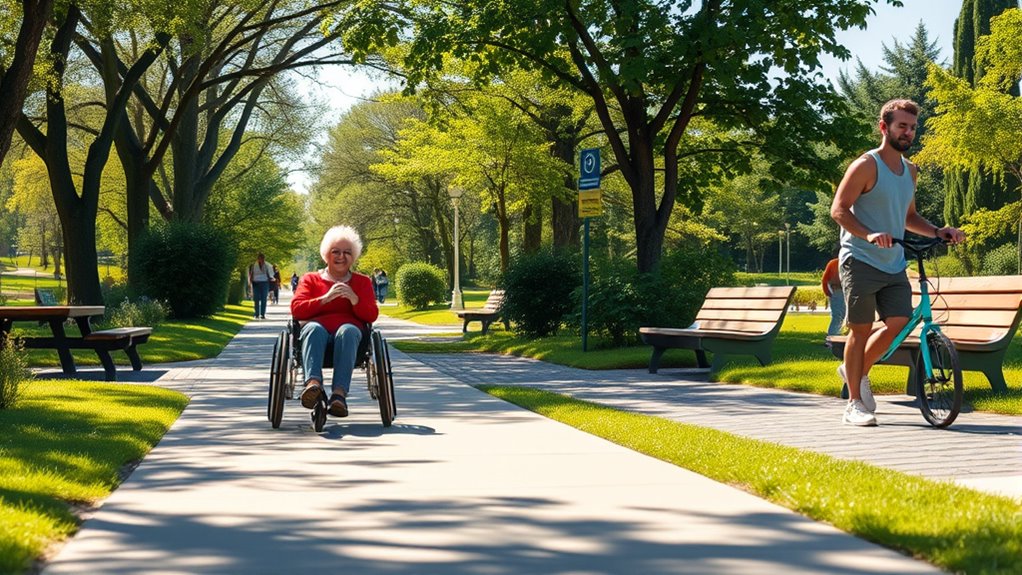
Have you ever considered how everyday spaces could better serve everyone, regardless of age? When you think about a home or a community, it’s easy to focus on aesthetics or basic functionality. But what if these spaces were designed with universal accessibility in mind? That’s where universal design for all ages comes into play, creating environments that are usable, safe, and comfortable for everyone, whether you’re young, elderly, or somewhere in between. It’s about thinking ahead and making small adjustments that have a big impact, especially in areas like smart home technology and outdoor accessibility.
A smart home is a perfect example of how technology can enhance universal design. With voice-activated controls, automated lighting, and smart thermostats, you can simplify daily routines and reduce the physical effort needed to *maneuver* your space. For instance, smart home systems can automatically adjust lighting to prevent falls or provide reminders for medication, making life easier and safer for users of all ages. These features aren’t just about luxury—they’re about inclusivity, ensuring that everyone can operate and benefit from the technology, regardless of mobility or dexterity. When your home adapts to your needs, it becomes more welcoming for guests of all ages, particularly those with temporary or permanent disabilities.
Outdoor accessibility is another *vital* aspect. Imagine a garden or porch designed with smooth, level pathways, ramps instead of stairs, and well-placed handrails. These features make it easier for everyone to enjoy outdoor spaces, whether you’re pushing a stroller, using a wheelchair, or simply *maneuvering* with mobility challenges. Accessible outdoor areas aren’t just beneficial for seniors—they encourage family activities, social interactions, and outdoor exercise for all ages. When pathways are clear and ramps are integrated seamlessly into the landscape, outdoor spaces become inclusive gathering spots that everyone can enjoy comfortably. Plus, accessible outdoor design promotes independence, allowing individuals to engage with nature or socialize without feeling limited by physical barriers.
Frequently Asked Questions
How Does Universal Design Impact Property Value?
You might notice that universal design boosts your property value by enhancing home safety and aesthetic appeal. When your home is accessible and easy to navigate, it appeals to a broader range of buyers, including those with mobility needs. Plus, stylish, thoughtful features make your property more attractive and modern. This combination of safety and beauty can lead to higher offers and faster sales, making your investment more rewarding over time.
Are Universal Design Features Cost-Effective?
Imagine a safety net catching you effortlessly—universal design features act similarly, offering cost savings and renovation benefits. You’ll find they’re cost-effective because they reduce future modifications, saving money long-term. Plus, they make your space adaptable for all ages, avoiding costly renovations later. Investing now means smoother upgrades later, making your property more resilient and valuable. Embracing universal design isn’t just smart; it’s a wise, cost-efficient choice for everyone.
Can Universal Design Be Customized for Individual Needs?
You can definitely customize universal design features to meet individual needs. Personal customization allows you to add adaptive features that suit your specific requirements, whether for mobility, vision, or other preferences. This flexibility guarantees the environment adjusts to you, not the other way around. By incorporating adaptive features, universal design becomes more inclusive, providing a tailored experience that enhances comfort, accessibility, and independence for everyone involved.
What Are Common Misconceptions About Universal Design?
Some folks think universal design limits style—like aging inclusion ruins aesthetics. But honestly, misconceptions like this overlook how thoughtful design enhances everyone’s experience. You don’t have to sacrifice aesthetic appeal for accessibility; smart features blend seamlessly. Universal design isn’t about boring sameness but creating spaces that serve all ages effortlessly. So, don’t buy into the myth that inclusion dulls beauty—it’s a win-win for comfort and style.
How Does Universal Design Influence Community Accessibility?
Universal design greatly enhances community accessibility by making public transportation and public spaces easier for everyone to use. You’ll notice that features like ramps, wider doorways, and clear signage benefit not just those with disabilities, but also seniors, parents with strollers, and anyone with temporary needs. This inclusivity creates a more welcoming environment, encourages community engagement, and guarantees that all individuals can participate fully in daily activities.
Conclusion
By embracing universal design, you create a world where everyone’s needs are woven together like a sturdy, inclusive fabric. It’s not just about accessibility; it’s about fostering a community that flows seamlessly across ages and abilities. When you prioritize these features, you’re planting seeds for a future where convenience and comfort grow side by side, transforming your environment into a welcoming harbor that welcomes all with open arms.
